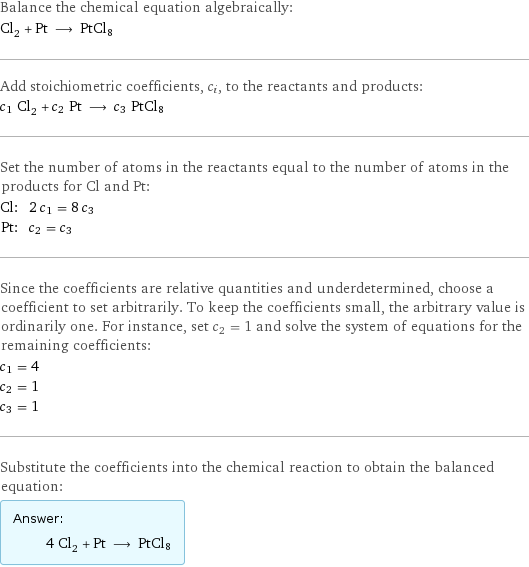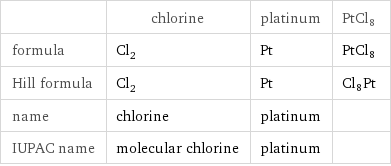Input interpretation

Cl_2 chlorine + Pt platinum ⟶ PtCl8
Balanced equation

Balance the chemical equation algebraically: Cl_2 + Pt ⟶ PtCl8 Add stoichiometric coefficients, c_i, to the reactants and products: c_1 Cl_2 + c_2 Pt ⟶ c_3 PtCl8 Set the number of atoms in the reactants equal to the number of atoms in the products for Cl and Pt: Cl: | 2 c_1 = 8 c_3 Pt: | c_2 = c_3 Since the coefficients are relative quantities and underdetermined, choose a coefficient to set arbitrarily. To keep the coefficients small, the arbitrary value is ordinarily one. For instance, set c_2 = 1 and solve the system of equations for the remaining coefficients: c_1 = 4 c_2 = 1 c_3 = 1 Substitute the coefficients into the chemical reaction to obtain the balanced equation: Answer: | | 4 Cl_2 + Pt ⟶ PtCl8
Structures

+ ⟶ PtCl8
Names

chlorine + platinum ⟶ PtCl8
Equilibrium constant
![Construct the equilibrium constant, K, expression for: Cl_2 + Pt ⟶ PtCl8 Plan: • Balance the chemical equation. • Determine the stoichiometric numbers. • Assemble the activity expression for each chemical species. • Use the activity expressions to build the equilibrium constant expression. Write the balanced chemical equation: 4 Cl_2 + Pt ⟶ PtCl8 Assign stoichiometric numbers, ν_i, using the stoichiometric coefficients, c_i, from the balanced chemical equation in the following manner: ν_i = -c_i for reactants and ν_i = c_i for products: chemical species | c_i | ν_i Cl_2 | 4 | -4 Pt | 1 | -1 PtCl8 | 1 | 1 Assemble the activity expressions accounting for the state of matter and ν_i: chemical species | c_i | ν_i | activity expression Cl_2 | 4 | -4 | ([Cl2])^(-4) Pt | 1 | -1 | ([Pt])^(-1) PtCl8 | 1 | 1 | [PtCl8] The equilibrium constant symbol in the concentration basis is: K_c Mulitply the activity expressions to arrive at the K_c expression: Answer: | | K_c = ([Cl2])^(-4) ([Pt])^(-1) [PtCl8] = ([PtCl8])/(([Cl2])^4 [Pt])](../image_source/7384b44eab9286fd2e3f37f9565a68c1.png)
Construct the equilibrium constant, K, expression for: Cl_2 + Pt ⟶ PtCl8 Plan: • Balance the chemical equation. • Determine the stoichiometric numbers. • Assemble the activity expression for each chemical species. • Use the activity expressions to build the equilibrium constant expression. Write the balanced chemical equation: 4 Cl_2 + Pt ⟶ PtCl8 Assign stoichiometric numbers, ν_i, using the stoichiometric coefficients, c_i, from the balanced chemical equation in the following manner: ν_i = -c_i for reactants and ν_i = c_i for products: chemical species | c_i | ν_i Cl_2 | 4 | -4 Pt | 1 | -1 PtCl8 | 1 | 1 Assemble the activity expressions accounting for the state of matter and ν_i: chemical species | c_i | ν_i | activity expression Cl_2 | 4 | -4 | ([Cl2])^(-4) Pt | 1 | -1 | ([Pt])^(-1) PtCl8 | 1 | 1 | [PtCl8] The equilibrium constant symbol in the concentration basis is: K_c Mulitply the activity expressions to arrive at the K_c expression: Answer: | | K_c = ([Cl2])^(-4) ([Pt])^(-1) [PtCl8] = ([PtCl8])/(([Cl2])^4 [Pt])
Rate of reaction
![Construct the rate of reaction expression for: Cl_2 + Pt ⟶ PtCl8 Plan: • Balance the chemical equation. • Determine the stoichiometric numbers. • Assemble the rate term for each chemical species. • Write the rate of reaction expression. Write the balanced chemical equation: 4 Cl_2 + Pt ⟶ PtCl8 Assign stoichiometric numbers, ν_i, using the stoichiometric coefficients, c_i, from the balanced chemical equation in the following manner: ν_i = -c_i for reactants and ν_i = c_i for products: chemical species | c_i | ν_i Cl_2 | 4 | -4 Pt | 1 | -1 PtCl8 | 1 | 1 The rate term for each chemical species, B_i, is 1/ν_i(Δ[B_i])/(Δt) where [B_i] is the amount concentration and t is time: chemical species | c_i | ν_i | rate term Cl_2 | 4 | -4 | -1/4 (Δ[Cl2])/(Δt) Pt | 1 | -1 | -(Δ[Pt])/(Δt) PtCl8 | 1 | 1 | (Δ[PtCl8])/(Δt) (for infinitesimal rate of change, replace Δ with d) Set the rate terms equal to each other to arrive at the rate expression: Answer: | | rate = -1/4 (Δ[Cl2])/(Δt) = -(Δ[Pt])/(Δt) = (Δ[PtCl8])/(Δt) (assuming constant volume and no accumulation of intermediates or side products)](../image_source/76d82879889a964573026ffcc30a314f.png)
Construct the rate of reaction expression for: Cl_2 + Pt ⟶ PtCl8 Plan: • Balance the chemical equation. • Determine the stoichiometric numbers. • Assemble the rate term for each chemical species. • Write the rate of reaction expression. Write the balanced chemical equation: 4 Cl_2 + Pt ⟶ PtCl8 Assign stoichiometric numbers, ν_i, using the stoichiometric coefficients, c_i, from the balanced chemical equation in the following manner: ν_i = -c_i for reactants and ν_i = c_i for products: chemical species | c_i | ν_i Cl_2 | 4 | -4 Pt | 1 | -1 PtCl8 | 1 | 1 The rate term for each chemical species, B_i, is 1/ν_i(Δ[B_i])/(Δt) where [B_i] is the amount concentration and t is time: chemical species | c_i | ν_i | rate term Cl_2 | 4 | -4 | -1/4 (Δ[Cl2])/(Δt) Pt | 1 | -1 | -(Δ[Pt])/(Δt) PtCl8 | 1 | 1 | (Δ[PtCl8])/(Δt) (for infinitesimal rate of change, replace Δ with d) Set the rate terms equal to each other to arrive at the rate expression: Answer: | | rate = -1/4 (Δ[Cl2])/(Δt) = -(Δ[Pt])/(Δt) = (Δ[PtCl8])/(Δt) (assuming constant volume and no accumulation of intermediates or side products)
Chemical names and formulas

| chlorine | platinum | PtCl8 formula | Cl_2 | Pt | PtCl8 Hill formula | Cl_2 | Pt | Cl8Pt name | chlorine | platinum | IUPAC name | molecular chlorine | platinum |
Substance properties

| chlorine | platinum | PtCl8 molar mass | 70.9 g/mol | 195.084 g/mol | 478.7 g/mol phase | gas (at STP) | solid (at STP) | melting point | -101 °C | 1772 °C | boiling point | -34 °C | 3827 °C | density | 0.003214 g/cm^3 (at 0 °C) | 21.45 g/cm^3 | solubility in water | | insoluble |
Units
